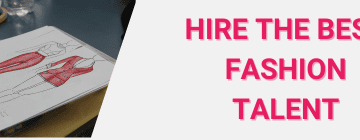Recruiting top fashion designers is crucial for any brand looking to stay ahead in the competitive fashion industry. Designers are the creative force behind innovative collections that captivate consumers and set trends. This blog provides in-depth insights into how to identify and attract the best design talent, sharing comprehensive tips from leading fashion recruiters.
Understanding What Makes a Top Fashion Designer
Key Attributes:
Top fashion designers possess a unique blend of creativity, technical skills, and industry knowledge. They have a keen eye for detail, a deep understanding of fabric and materials, and the ability to forecast and set trends. Recruiters should look for candidates with a strong portfolio, relevant experience, and a keen sense of current fashion trends.
Evaluating Portfolios:
A designer’s portfolio is a critical component of their application. Look for diversity in their work, attention to detail, and evidence of their ability to innovate while maintaining commercial viability. The portfolio should demonstrate a range of skills, from sketching and pattern making to digital design and garment construction.
Example: Leading brands like Gucci and Prada prioritize designers who not only have innovative ideas but also understand the technical aspects of garment construction and material selection.
Utilizing Specialized Fashion Recruitment Agencies
Advantages of Specialized Agencies:
Working with specialized fashion recruitment agencies can streamline the hiring process. These agencies have extensive networks and understand the specific needs of the fashion industry. They can provide access to a pool of highly qualified candidates who may not be actively looking for new opportunities but are open to the right offer.
Agency Services:
Specialized agencies can assist with every stage of the recruitment process, from defining the job role and requirements to vetting candidates and conducting initial interviews. They can also provide insights into industry salary benchmarks and hiring trends.
Example: The Fashion Network specializes in recruiting top talent for various fashion roles, including designers, ensuring that brands have access to candidates who meet their exact requirements. This agency’s deep industry knowledge helps match the right candidates with the right opportunities.
Leveraging Social Media and Professional Networks
Social Media Platforms:
Social media platforms like LinkedIn, Instagram, and fashion-specific job boards can be valuable tools for finding and attracting top designers. Brands can use these platforms to showcase their company culture, values, and the exciting projects they are working on. This approach not only attracts active job seekers but also engages passive candidates who may be inspired by what they see.
Building an Online Presence:
Regularly posting about company achievements, employee stories, and behind-the-scenes looks at the design process can create a compelling narrative about your brand. Engage with potential candidates by responding to comments and messages, and participate in industry discussions to raise your profile.
Example: Brands like Zara and H&M use their social media presence to highlight their innovative projects and inclusive work culture, attracting top design talent. They share stories of their design teams, showcase new collections, and provide insights into their creative processes.
Offering Competitive Compensation and Growth Opportunities
Attractive Compensation Packages:
To attract top designers, offer competitive salaries, benefits, and clear career advancement opportunities. Compensation should reflect the candidate’s experience, skills, and the value they bring to the company. Additionally, consider offering performance bonuses, profit-sharing, and other financial incentives.
Career Development:
Highlight the potential for professional growth and creative freedom within your brand. Provide opportunities for ongoing education, such as workshops, courses, and conferences. Mentorship programs can also be highly attractive to designers looking to develop their skills and advance their careers.
Example: Patagonia is known for its attractive benefits package, including flexible working hours, on-site childcare, and environmental internships, making it a desirable employer in the fashion industry. This can help in appealing to the best fashion headhunters and fashion employment agencies.
Creating a Positive Workplace Culture
Work Environment:
A positive and supportive work environment is crucial for attracting and retaining top talent. Foster a culture of creativity and collaboration where designers feel valued and inspired. Encourage open communication, recognize and reward achievements, and provide the resources needed for designers to excel.
Inclusivity and Diversity:
An inclusive workplace that values diversity can attract a broader range of talent. Ensure that your hiring practices promote diversity and create an inclusive environment where all employees feel valued. Diverse teams bring different perspectives and ideas, leading to more innovative designs.
Example: Companies like Nike and H&M have diversity and inclusion initiatives that not only improve their workplace culture but also attract diverse talent. This is particularly important for fashion recruiters or staffing agencies, headhunters, and employment agencies.
Partnering with Fashion Schools and Universities
Educational Partnerships:
Building relationships with fashion schools and universities can help you tap into a pool of emerging talent. Offer internships, sponsor events, and participate in campus recruitment to attract young professionals. Engage with students through guest lectures, workshops, and portfolio reviews to identify potential hires early.
Internship Programs:
Internship programs provide students with real-world experience and allow brands to evaluate potential employees’ skills and fit within the company culture. Offering paid internships and clear pathways to full-time employment can make your brand more attractive to top students.
Example: The CFDA (Council of Fashion Designers of America) collaborates with top fashion schools to provide scholarships and mentorship, connecting brands with new talent. This is beneficial for fashion placement agencies or firms in NYC.
Utilizing Recruitment Agencies and Headhunters
Specialized Recruitment Firms:
Fashion recruitment agencies and headhunters have extensive networks and expertise in the industry. They can help you find candidates who meet your specific needs and fit your company culture. These agencies often have access to passive candidates who are not actively looking but might be open to the right opportunity.
Streamlining the Hiring Process:
Recruitment agencies can manage the entire hiring process, from initial outreach and candidate screening to interview coordination and salary negotiations. This can save time and ensure that you find the best possible candidates.
Example: The Fashion Network, a leading recruitment agency, specializes in finding top talent for fashion, e-commerce, and retail industries, ensuring that their clients have access to the best professionals in the field. This makes them one of the best fashion staffing agencies in the USA.
Creating a Positive Candidate Experience
Efficient Hiring Process:
A smooth and efficient hiring process leaves a positive impression on candidates. Communicate clearly, provide timely feedback, and make the application process as straightforward as possible. Candidates should feel valued and respected throughout the process.
Onboarding and Integration:
Once a candidate is hired, an effective onboarding process is crucial. Provide new hires with the resources and support they need to integrate smoothly into the team. Clear communication, training, and mentorship can help new designers hit the ground running and feel at home in their new role.
Example: Zappos is known for its candidate-friendly hiring process, which includes clear communication and a commitment to providing a positive experience for all applicants. This approach is effective for executive fashion recruiters and fashion search firms.
Conclusion
Attracting top talent in the fashion industry in the USA requires a multifaceted approach that includes building a strong employer brand, leveraging social media, offering competitive benefits, fostering diversity, partnering with educational institutions, utilizing recruitment agencies, and creating a positive candidate experience. By implementing these strategies, fashion brands can ensure they attract and retain the best professionals to drive their success.


